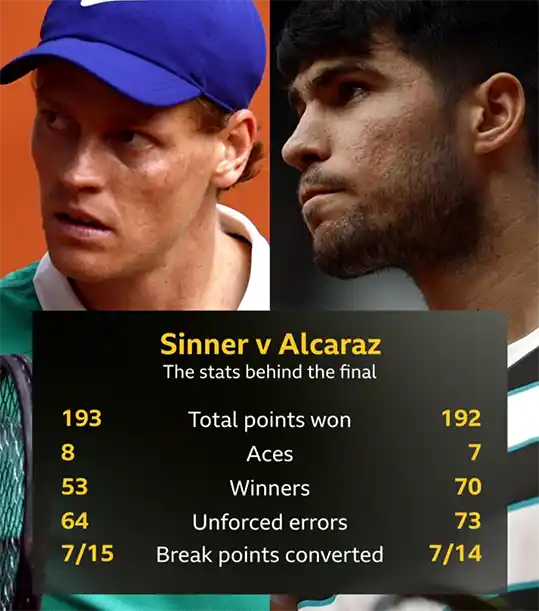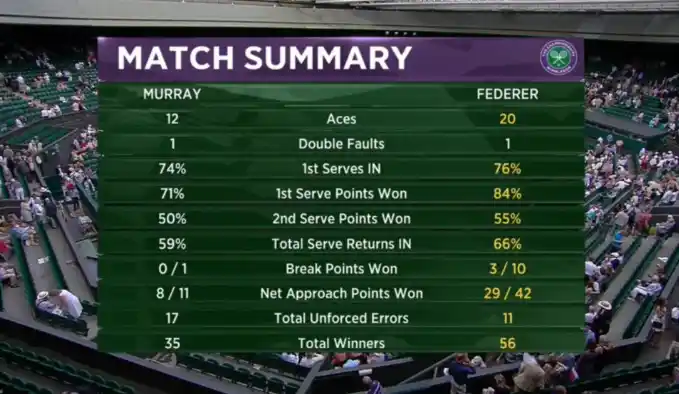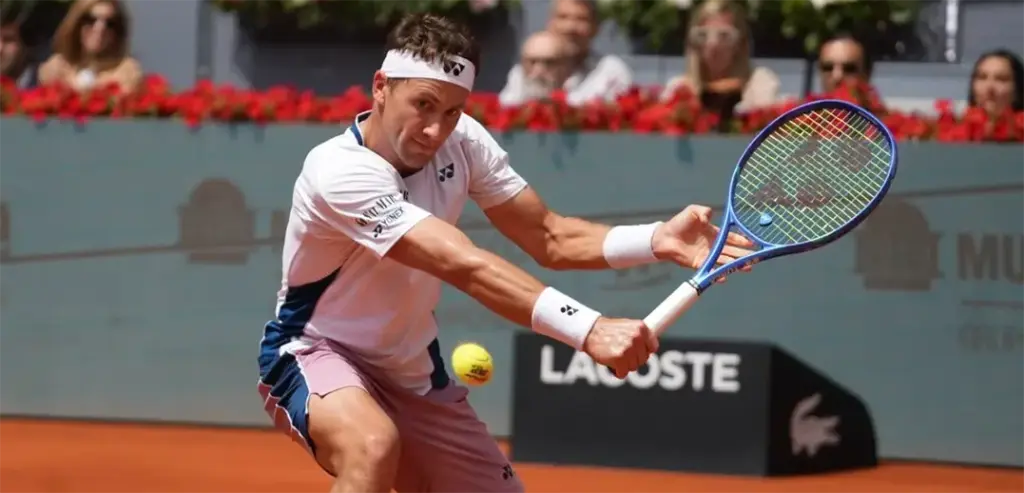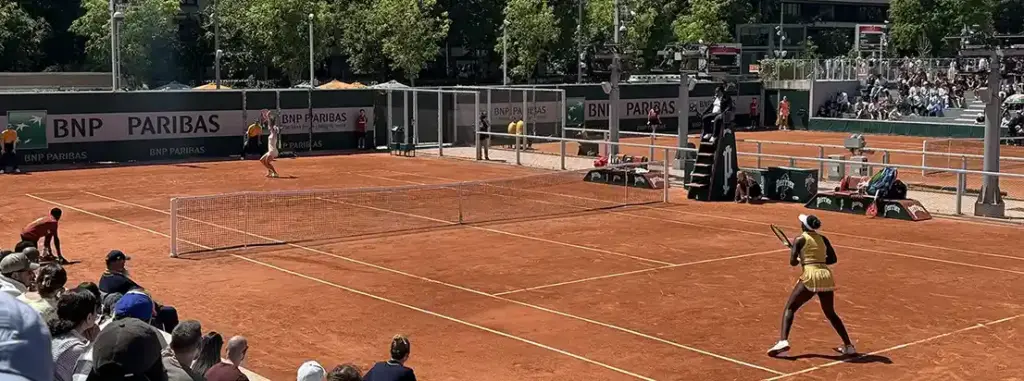Tennis is a sport with an almost infinite amount of stats and data to track. Over the past decade, these numbers have become more and more important at the highest level of the game.
For the casual fans, tennis statistics are not so make-or-break. However, if you’re eager to pull back a few layers and understand a match better; or, if you’re curious to know how a match is likely to play out, knowing what stats to look for is important.
Below we go over all the most important tennis statistics. We’ve broken these down into two main categories, looking at the macro and micro. There are plenty we haven’t gone into, but the ones below will give you a good platform to start from.
Key in-game tennis statistics
Winners
Winners are one of the most telling stats in tennis of how a match unfolded. After all, a winner is defined pretty concisely. It’s a shot that wins a player the point directly, without their opponent getting racket on ball. That’s a pretty big deal because some of the most crucial points in the vast majority of matches end with a winner.
So what do winners tell us? They can tell us a couple of things. First of all, they can tell us how aggressive a player was in the match. That often impacts the match directly. More aggression doesn’t always mean better, but if you combine more aggression with a good amount of shot-making, you have a good combination.
The amount of winners doesn’t mean that it’s the tell-all stat. Sometimes it can be deceptive, especially with players such as Nikoloz Basilashvili who enjoy playing quick and snappy matches. Oftentimes he will have more winners than his opponents but also many more unforced errors which offset those winners.
Players have had more winners than their opponents and lost matches, which tells you how complicated the sport of tennis can be and why stats, while useful, don’t always tell the whole story.
Unforced errors
This is the flip side of the winner equation because oftentimes when a player attempts to hit a winner but misses, he ends up with an unforced error. In many ways, unforced errors are an even bigger telltale sign of how a player performed during a tennis match. Many players are playing aggressive tennis these days.
The days of defensive tennis are over, as more and more players attempt to hit outrageous shots and generally bring a lot more power in their shots than in years past. That results in the number of winners going up dramatically, but also the amount of unforced errors.
Many players can try and hit a shot like Sinner or Alcaraz, but what makes those guys special is the ability to actually hit them and not slam them a couple of meters behind the baseline or into the net.
Oftentimes when you see a player losing, his unforced error numbers will be higher than that of his opponent. It doesn’t always happen, but oftentimes it does because anytime an unforced error happens, a player lost the point, and anytime a player lost the point is a time when he’s closer to getting beaten.

First serve percentage
Another hugely important stat in the world of tennis is the first serve. To keep it simple and concise, the first serve is generally much better for most players than the second serve. It’s usually more powerful, has more pace on it, generally is more risky in terms of the angle, and generally is more effective at creating an advantage in the sport.
As the only shot that you can fully control in tennis, the serve is a premium weapon when used right. It’s why Rafael Nadal complained that these days the sport is looking the same whoever plays, because most players coming up through the ranks come with a massive serve.
That’s no coincidence, because a massive serve is a huge advantage in the sport. Sinner didn’t become world number one until he fixed his serve and turned it into a massive weapon, and can you imagine what Alcaraz could do if his serve was a massive weapon? Quite a lot.
So the higher the percentage of the first serve, the more likely you are to win the match. It’s not a 100% thing because players like John Isner and Reilly Opelka still lose matches, but the more first serves you hit, the more advantage you have in rallies, which can help you win a match.
And if you have a tight match between two players, generally the one who is closer to 70% on his first serve is more likely to win than the one who is closer to 50%, which is why this is one of the most important stats in tennis.
Break point conversion
Everything in tennis is about the numbers. It’s a numbers sport because to win a game you have to win a certain amount of points. To win a set you have to win a certain amount of games, and to win a match you have to win a certain amount of sets. So it’s not hard to see how the number of break points converted could matter.
It’s not the be-all, end-all, of course. None of these stats are, as players have won matches without having a single break point, let alone not converting break points, but generally it’s a good indicator.
Let’s say you have Player A who had five break chances but used only one. Then you have Player B who had two but used both. Chances are that B was closer to winning the match. Some players like Alcaraz are notoriously complacent on break points, and it can get problematic at times.
If he did a much better job converting those break points, he would certainly have won some of those matches much easier than he ultimately did.
Second serve return win percentage
Novak Djokovic has become the greatest tennis player of all time thanks to his return. Obviously, it’s not only because of his return but rather his complete skillset, but his return has given so many players problems because the second serve can be such a liability when facing a great return.
That’s why anything second serve-related matters. The percentage hugely matters. The power hugely matters. The effectiveness of it hugely matters. You simply cannot survive in today’s tennis with a super weak second serve.
It has to be serviceable at least, and some players with a bad second serve have had massive problems, legends included. Nadal’s second serve was pretty bad early on, but it got better, and when it got better, he became a much better tennis player.
Honorable mention – ace rate
This is another stat that matters, but it doesn’t matter as much as people think. An ace is a service winner when the other player hasn’t touched the ball. It’s a directly won point and as such obviously matters.
Now it’s not something that happens all too often, but some players who have a powerful serve have tipped matches into their favor simply by virtue of their serve. Aces can be part of that. Take someone like Matteo Berrettini for example.
He’s been able to wiggle out of really complex situations by virtue of his serve, which often bails him out when he’s facing break points. Some of those points are aces, and there is nothing the opposing player can do. It’s a lost point, and some matches have been decided by one point. Some of those were aces.

Key macro tennis statistics
Head-to-head record
Perhaps the most important macro tennis stat to take into account before a match is the head-to-head record between two players.
Take Iga Swiatek vs Jelena Ostapenko. Swiatek dwarfs her in win rate, ranking and titles won. However, Ostapenko leads the head-to-head 6-0. There’s simply something about Swiatek’s ball that suits Ostapenko’s ultra-aggressive hitting, and it overrides almost every other advantage Swiatek may have on paper.
It’s important to dive right into a head-to-head and look at recent meetings too. For example, the head-to-head between Sinner and Alcaraz is 8-4, but of those, Alcaraz has won the last five. You can check the updated H2H’s on the ATP tour website, for example the H2H for Sinner and Alcaraz.
Surface win rate
A player’s win rate on a particular surface is another key factor to be aware of heading into any match. While some players deliver consistent results across all court types, others are far more specialized.
For example, Casper Ruud has a 69.3% win rate on clay over his career. However, on hard court that win rate drops to 59.2%. Therefore, the Norwegian is a much stronger favorite heading into any match on clay, compared to hard court.

Recent form
This stat is about as basic as it gets, but it’s still important to consider. Say the world No 69 is heading into a clash against the world No 21. Naturally, you’d expect that higher ranked player to be a heavy favorite.
But not if their form is widely different. The world No 69 may have just won a Challenger title and be sitting on a 10-match win streak, while the world No 21 could be sitting on four first-round exits in a row. This kind of information will have a significant impact on how a match is likely to go, so it’s critical to be aware of.
Win vs rank
Getting slightly more niche, an interesting tennis statistic is a player’s win rate vs certain ranks of opposition. For example, a player such as Daniel Altmaier wouldn’t appear to be much of a threat to high-ranked players, given the German has a peak ranking of No 47 in the world. However, he has a stellar record against top-10 players, having won five of his 12 matches against opponents in the top 10.
Likewise, other players may appear to be in good form, but don’t have a strong record when it comes to playing the sport’s elite. Alexander Zverev, for example, has consistently been ranked in the world’s top five the past half a decade, but is 1-13 against top-five opposition at Grand Slams across his career.
Honorable mention – best of five record
Speaking of Grand Slams, understanding a player’s best-of-five record is worth a mention too. This is the kind of tennis stat that comes handy once in a blue moon, but has an impact nonetheless.
Some players simply thrive in the best-of-five format more than others. There are the obvious ones, such as Novak Djokovic, who simply becomes harder to beat over the longer format of the games. Others, though, may be more of a surprise. Karen Khachanov, for example, has a much better win rate in best-of-five sets, sitting a full 7% higher in the format.
A note on tennis statistics
Once again, we have to reiterate that tennis is a sport of numbers. Ultimately, most sports are. Things are quantified and counted in numbers, and tennis is no different. But it’s also a sport where numbers don’t always tell the whole story.
In fact, some numbers can be misleading. You can dominate the stats and still lose the match. You can have more winners and fewer unforced errors and lose the match. You can have more aces and still lose the match.
You can have better serve efficiency and still lose the match. You can even win fewer points in a tennis match than your opponent and win the match. There is no such thing in any other sport, which makes this a unique one.
So while the stats we mentioned above are hugely important, they’re not essential. What is essential is who wins the point before the famous “game, set, match” follows. The rest is just data – and while data is beautiful, it’s just that – data.

